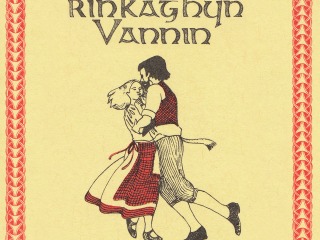MENU
01 Dec 2011
“THE EVILS OF HOLDING ILL-VERIES”
CARVAL SINGING IN THE ISLE OF MAN
by Stephen Miller
This phrase comes from a meeting of the Manx Methodist conference in 1817, held at Ballakaneen (Andreas) in October of that same year:
Another long conversation took place respecting the evils of holding Ill-Veries, And they were again condemned by all present except two or three who pleaded for them. They were condemned, first as being contrary to our Lord’s words, G John chap. 4th and verse 24th where it is declared that “God is a Spirit: and they that worship him must worship him in Spirit and in Truth But in these Meetings an Individual will start up and sing a Corral twenty or thirty verses long, some of it sense, and some of it Nonsense, and one after another continuing this practice for several hours, and that the worst of Characters for Miles round the places where they are held.
Secondly. They were condemned on the ground of the disorderly work which is carried on at them.
On the evening of Christmas Day, the vicar or rector would effectively hand the parish church over to the “lower orders,” the servants and labourers who then sat in the pews of their masters and mistresses, the females ready with their parched peas to throw at those whose carval singing they felt was not up to be scratch.
As regards “disorderly work,” this phrase well captures the carnivaleqsue nature of the Oie’l Voirrey itself: the parish church taken over by those who do not rent pews, amongst whom many have their own composed carvals in Manx to sing to be approved (or not as the case may be) of those there assembled. Some it was felt took it a little too far as this presentment to the Chapter Quest in 1705 shows:
Wm Fry and Jo: Caine prsented by Robt Caineon one of ye Questmen for yr misbehaviour in ye Ch: on Xstmas day in ye morning by Striking others with bushes of holling to ye disturbance of ye people
They were sentenced to a day’s confinement in the crypt of St German’s cathedral on Saint Patrick’s Isle. Thanks are due to the pair as their presentment provides the earliest mention to date of the Oie’l Voirrey itself.
That said, it is interesting that Waldron, a seasoned observer living in the Island in the 1720s, does not mention the Oie’l Voirrey at all and instead has on this date taking place the calendar custom of “Hunt the Wren”:
CHRISTMAS is ushered in with a Form much less meaning, and infinitely more fatiguing. On the 24th of December, toward Evening, all the Servants in general have a Holiday, they go not to Bed all Night, but ramble about till the Bells ring in all the Churches, which is at twelve-a-clock; Prayers being over, they go to hunt the Wren, and after having found one of these poor Birds, they kill her, and lay her on a Bier with the utmost Solemnity, bringing her to the Parish-Church, and burying her with a whimsical kind of Solemnity, singing Dirges over her in the Manks Language, which they call her Knell; after which Christmas begins.
It is certainly clear that “Hunt the Wren” shifts to being celebrated on the 26th December, St Stephens Day, at some date during the 1700s—but for the presentment from 1705 as here I would have argued that “Hunt the Wren” was shifted in order to accommodate carval singing but it would appear that both took place on the same day in this period though “Hunt the Wren” was still shifted in date in due course during the 1700s.
The good folk of Ballaugh in 1758, were clear about what was expected on Oie’l Voirrey although stated in a petition from the so-named “Principall Inhabitants & Masters of Families in the Parish of Ballaugh”:
That we do hereby declare our utter Abhorrence & Resentment of the Unworthy & Unbecoming Behaviour of some of our Young People & others unknown, towards the Rev[eren]d Mr Moore our Rector, on the eve of last Christmas Day & the morning of the same, in riotously surrounding his House & throwing up stones on the Roof to the great Terror & Annoyance of his Family with outragious Noise & Tumult, calling on Him, at an Unusual & Unseasonable Time, to come forth, & do his Duty at the Ill-Verry—though & repeatedly told that He was so very Ill in his Bed that He could not possibly come […].
This petition failed and “The Wardens, upon the Complaint of Tho[ma]s Stephen, present the Rector for not performing Divine Service before Daylight on Christmas Day, commonly called the Oie-Il-Wurrey—Referr’d to Tryal”.
Carval singing and the composition of such carols are a remarkable Insular phenomenon and the carvals themselves are a body of vernacular Manx that deserves further study. A collection was drawn together by A.W. Moore in his Carvalyn Gailckagh from 1891, and C.I. Paton later ran a column in the Isle of Man Examiner (1915–17) reproducing material not found in Moore. The planned book never appeared.
The Oie’l Voirrey in the early eighteenth century was remembered in Andreas so:
At Christmas Eve, called ‘Eel Varrey,’ the church presented an extraordinary appearance. Crowds came with candles stuck in hollow turnips and holly boughs which they held before them. They sung carols of their own composition and kept watch until midnight.
It is also described in verse in William Kennish’s volume of Insular poems, Mona’s Isle, and Other Poems (1844). Archdeacon Kewley in 1923, fondly recalled the evening:
And the Oie’ll Viorrey; the kishans of evergreens; the forest of firs nailed vertically in the angles of the pews; the big guttering candles for the only evening service in the course of the year; the carvals of interminable length, doubtful rhyme and metre, and successfully disguised melody; the tramp home in the snow; the hibbin, the holly […].
By this date, the Oie’l Voirrey had passed into fond memory as here.

Manx delegation for Lorient 2024
30 Apr 2024
Read More...
Rinkaghyn Vannin – Manx dance book and cassette released online
19 Apr 2024
Read More...
North American Manx Association 2024 nominations invited
16 Apr 2024
Read More...
Contact, Links, Acknowledgements, Privacy
© Culture Vannin. Culture Vannin is the trading name for the Manx Heritage Foundation, registered charity 333 in the Isle of Man. Designed by 3 Legs Ltd.